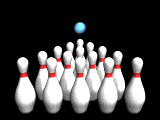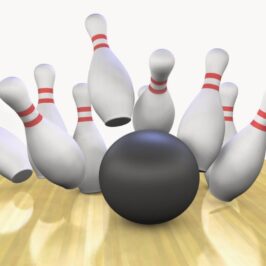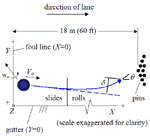Ever heard the expression “Rotation, rotation, rotation”? One can’t help but notice the effect of ball rotation on pinfall. The ball hits the pins spinning, causing them to spin. Rotation adds to the chaos already in progress by the impact itself. The angle, speed, and direction, of all bodies involved on contact, is the stuff strikes are made of. Following is an effort, a collection of information, about what happens when a bowling ball hits the pins. Don’t be dismayed by what you see here as some of the physics Does border rocket science.
I started as a bowler with a urethane ball that had no internal weight block. Scores were 140-160, IF I was lucky, certainly nothing to talk about. My ball went straight. When I tried to twist the ball to get it to spin, the result was intense wrist pain. Once I moved up to a better ball with a weight block, I found I still had little to no rotation. The weight block in these balls did not help. Scores were no better. I wasn’t twisting the ball. I was barely able to hold on to it. There were lots of folks around me with high revs, many with what I call “The Natural“, a deep wrist bend that allows the ball to sit on the thumb instead of being held By the thumb, who were consistently scoring higher. The only way I could hold the ball in order to release it at all was with the the thumb as well as two fingers. This caused blisters and callouses that have never gone away. Teachers, knowledgeable bowlers alike said the thumb has to “drop out” of the ball – For me, How, when it is holding the ball?!! It doesn’t take but a minute to notice the difference in scoring between folks who have taught themselves to sit the ball on the thumb and release twisting the ball as it meets the lane, and those who don’t. In addition, I never learned to just –
Folks who can grip the bowling ball this way are generally called Crankers and generate huge revs and often more ball speed. Due to the aforementioned pain, I was stuck to being a “stroker”, folks who create their revs at the fingers instead of actually twisting the ball using wrist strength. Strokers can have high accuracy, consistency, but lack the revs. Pros, as well as most good bowlers, use a combination of cranking and stroking – The best of both worlds.
The following link gives you hard facts, an elegant treatise on the physics of bowling: http://www.real-world-physics-problems.com/physics-of-bowling.html. It’s a little heavy in formula but tells an accurate story.
A more simple explanation from BowlingBall.com:
Axis Tilt and Axis Rotation
Axis tilt and axis rotation deal with the angle at which the ball is revolving. The ball revolves on two planes: 1) horizontal, and 2) vertical. The angle of the ball’s revolutions dictates the resistance to forward roll. Resistance to forward roll is synonymous with skid, delaying the breakpoint of the ball. The breakpoint is the point on the lane where the ball starts to make its move to the pocket.
Axis tilt is the vertical angle at which the ball rotates. Axis tilt is what is commonly known as spin. Axis tilt is determined by the position of the thumb during the release. If the hand turns too early, the thumb exits on top of the ball. Bowlers with a high degree of axis tilt will be able to see the top of their hand during the release and follow through. Being able to have the thumb exit at the bottom of the down swing minimizes axis tilt.
Axis tilt will induce skid and reduce the amount of backend hook potential. With the core rotating in a more vertical fashion, oily lanes will be the enemy, drier lanes its friend.
Axis rotation is the horizontal measure of the angle of the ball’s revolutions. It is also determined by the release. It is the release position of the fingers that dictates the amount of axis rotation. Axis rotation is commonly known as side roll. When the fingers exit the ball in a 6:00 position, the ball is sent into an end-over-end roll. This is known as 0 degrees of axis rotation, the absolute minimum. This ball will have no chance of hooking, regardless of the amount of revolutions, ball speed, and lane conditions. The ball will have immediate forward roll. Think of it as being behind the wheel of a car with the steering wheel straight. The tires will face in a north-south direction. The car will go straight, not being able to negotiate a curve in the road.

 If the fingers exit the ball in a 3:00 position, caused by a rotation of the hand in a counter-clockwise direction, 90 degrees of axis rotation will result. This will give the ball a tremendous hook angle when it encounters friction. This is similar to being in that same car. However the steering wheel is now turned so that the tires are angled to the left. When the accelerator is engaged, the car will jerk violently to the left. (For lefthanders, the fingers will exit the ball at a 9:00 position, the hand rotates in a clockwise direction, and the car wheels would be pointed to the right).
If the fingers exit the ball in a 3:00 position, caused by a rotation of the hand in a counter-clockwise direction, 90 degrees of axis rotation will result. This will give the ball a tremendous hook angle when it encounters friction. This is similar to being in that same car. However the steering wheel is now turned so that the tires are angled to the left. When the accelerator is engaged, the car will jerk violently to the left. (For lefthanders, the fingers will exit the ball at a 9:00 position, the hand rotates in a clockwise direction, and the car wheels would be pointed to the right).
Most players have a finger exit somewhere in between 0 and 90 degrees. The halfway point, 45 degrees, will see the fingers exit the ball at 4:30 at the release point (7:30 for lefthanders). This is the most versatile release position. Please consult the Surface Friction Guide, True Grit, for pictures of axis rotation and axis tilt.
Axis rotation also will cause the ball to skid further but, unlike axis tilt, will cause a dramatic hook angle at the breakpoint. 90-degree axis rotation is often quite uncontrollable at the breakpoint. High degree of axis rotation players will also tend to like drier lanes; minimal axis rotation will tend to like more oil.
The ball, as it is rolling down the lane, will lose axis rotation due to encountering friction. The rate at which the ball loses axis rotation (side revolutions turning into end-over-end revolutions) will be determined by the initial axis rotation, the amount of ball speed, the amount of axis tilt, and the amount of oil on the lane. For the best carry percentage, we want the ball to lose axis rotation (enter into an end-over-end roll) just as it enters the pocket. This will give a strong angle of entry into the pocket and the proper amount of deflection.
Your pro shop technician will be able to assist you in determining your axis tilt and axis rotation. While it is not necessary to know the exact angle, knowing whether you have low, medium, or high amounts of each will make understanding your ball’s reaction easier.
To help increase rotation, manufacturers have created an endless selection of internal weight blocks and cover stocks that help, and cause, the ball to spin differently at various angles and speeds. These weight blocks and how the ball is drilled in relation to the individual stroke, are major factors in determining how the ball will run the lane and what will happen at the end. Add how the ball is affected by lane conditions at any given time and it becomes more complicated yet. Take a look at some of the videos on manufacturer’s web sites to get a look at the differences these weights make. In addition to other factors, the ability to adjust the amount of rotation one puts on the ball is essential in controlling where and when the ball will break, what the effect is at the pins.
Take a look at these examples. The higher revving shots knock down more pins! Higher speed along with accuracy/consistency add to the mix. The shots shown with loft here do not produce the number of strikes as the ones with “The Natural”, that special grip that allows the shooter to get under the ball and give it more twist on release.







kody
While the videos showing the loft and rotation are great, I think you should add the video of a down and in bowler that rarely uses loft. This would be helpful to show the differences in the amount of axis tilt and rotation, while achieving the same desired result. Just something to think about.